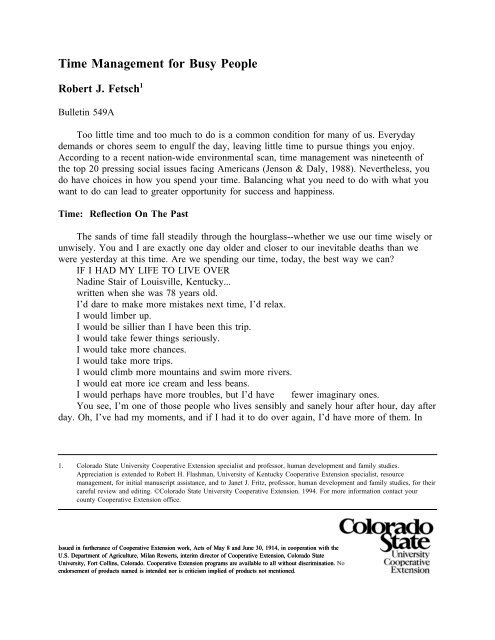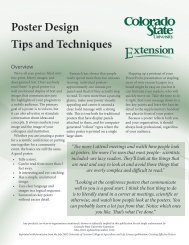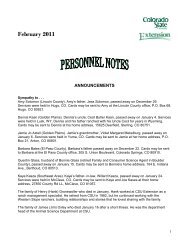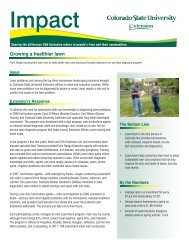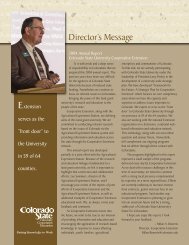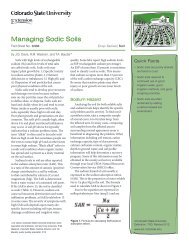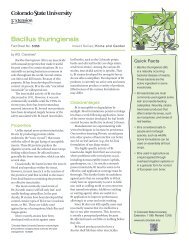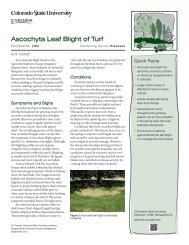Time Management for Busy People - Colorado State University ...
Time Management for Busy People - Colorado State University ...
Time Management for Busy People - Colorado State University ...
Create successful ePaper yourself
Turn your PDF publications into a flip-book with our unique Google optimized e-Paper software.
<strong>Time</strong> <strong>Management</strong> <strong>for</strong> <strong>Busy</strong> <strong>People</strong><br />
Robert J. Fetsch 1<br />
Bulletin 549A<br />
Too little time and too much to do is a common condition <strong>for</strong> many of us. Everyday<br />
demands or chores seem to engulf the day, leaving little time to pursue things you enjoy.<br />
According to a recent nation-wide environmental scan, time management was nineteenth of<br />
the top 20 pressing social issues facing Americans (Jenson & Daly, 1988). Nevertheless, you<br />
do have choices in how you spend your time. Balancing what you need to do with what you<br />
want to do can lead to greater opportunity <strong>for</strong> success and happiness.<br />
<strong>Time</strong>: Reflection On The Past<br />
The sands of time fall steadily through the hourglass--whether we use our time wisely or<br />
unwisely. You and I are exactly one day older and closer to our inevitable deaths than we<br />
were yesterday at this time. Are we spending our time, today, the best way we can?<br />
IF I HAD MY LIFE TO LIVE OVER<br />
Nadine Stair of Louisville, Kentucky...<br />
written when she was 78 years old.<br />
I’d dare to make more mistakes next time, I’d relax.<br />
I would limber up.<br />
I would be sillier than I have been this trip.<br />
I would take fewer things seriously.<br />
I would take more chances.<br />
I would take more trips.<br />
I would climb more mountains and swim more rivers.<br />
I would eat more ice cream and less beans.<br />
I would perhaps have more troubles, but I’d have fewer imaginary ones.<br />
You see, I’m one of those people who lives sensibly and sanely hour after hour, day after<br />
day. Oh, I’ve had my moments, and if I had it to do over again, I’d have more of them. In<br />
1. <strong>Colorado</strong> <strong>State</strong> <strong>University</strong> Cooperative Extension specialist and professor, human development and family studies.<br />
Appreciation is extended to Robert H. Flashman, <strong>University</strong> of Kentucky Cooperative Extension specialist, resource<br />
management, <strong>for</strong> initial manuscript assistance, and to Janet J. Fritz, professor, human development and family studies, <strong>for</strong> their<br />
careful review and editing. ©<strong>Colorado</strong> <strong>State</strong> <strong>University</strong> Cooperative Extension. 1994. For more in<strong>for</strong>mation contact your<br />
county Cooperative Extension office.<br />
Issued in furtherance of Cooperative Extension work, Acts of May 8 and June 30, 1914, in cooperation with the<br />
U.S. Department of Agriculture, Milan Rewerts, interim director of Cooperative Extension, <strong>Colorado</strong> <strong>State</strong><br />
<strong>University</strong>, Fort Collins, <strong>Colorado</strong>. Cooperative Extension programs are available to all without discrimination. No<br />
endorsement of products named is intended nor is criticism implied of products not mentioned.
<strong>Time</strong> <strong>Management</strong> <strong>for</strong> <strong>Busy</strong> <strong>People</strong> Page 2<br />
fact, I’d try to have nothing else. Just moments, one after another, instead of living so many<br />
years ahead of each day.<br />
I’ve been one of those persons who never goes anywhere without a thermometer, a<br />
hot-water bottle, a raincoat and a parachute. If I had it to do again, I would travel lighter than<br />
I have.<br />
If I had my life to live over, I would start barefoot earlier in the spring and stay that way<br />
later in the fall.<br />
I would go to more dances.<br />
I would ride more merry-go-rounds.<br />
I would pick more daisies.<br />
What Is Good <strong>Time</strong> <strong>Management</strong>?<br />
<strong>Time</strong> management does not mean being busy all the time. It means using your time the<br />
way you want to use it--which can include large doses of daydreaming and doing nothing.<br />
Good time management brings increased relaxation, reduced stress, personal satisfaction, and<br />
successful goal accomplishment. (Dorothy Cudaback, May 1980.)<br />
The key to get what you want out of life is to know where you are going. Goal setting is<br />
a critical life skill to effective time-life management.<br />
Many of us blame others <strong>for</strong> wasting our time. "It’s not my fault I’m late--that child of<br />
mine refuses to hurry up!" "Everybody always asks me to do more things when I already<br />
have too much to do!" "If it wasn’t <strong>for</strong> , I would have been able to ."<br />
As long as you play the "blame game," you assume little responsibility <strong>for</strong> improving<br />
your life. Once you accept responsibility on how to spend your time, you regain power to<br />
direct your life.<br />
Many people complain that they do not have enough time. But honestly, you have<br />
enough time to do what is important. You can always make time <strong>for</strong> the people and activities<br />
you value. See each day as a new opportunity to practice mastering your time.<br />
<strong>Time</strong> is one of the deepest mysteries known to men and women. No one can say exactly<br />
what it is, other than we pass it, make it, take it, spend it, crave it, kill it, and enjoy it.<br />
Although most of the planet’s resources and wealth are distributed unequally to earthlings, of<br />
daily time we each have 24 hours.<br />
You cannot really manage time that passes at a predetermined rate--8,760 hours per<br />
year--regardless of what you do. You can, however, learn to manage yourself.<br />
Why Do You Want To Change How You Manage Your <strong>Time</strong>?<br />
To begin taking charge of your life, ask why you want to manage your time better. Take<br />
a minute to list the reasons you want to manage your time better.<br />
1.<br />
2.<br />
3.<br />
4.
<strong>Time</strong> <strong>Management</strong> <strong>for</strong> <strong>Busy</strong> <strong>People</strong> Page 3<br />
5.<br />
Some people want to manage time to earn more money or increase productivity. Others<br />
want to free themselves from "hurry sickness" and allow time <strong>for</strong> themselves and personal<br />
growth. Others want more time to spend with family and friends.<br />
How Do You Want To Change?<br />
What do you want to do differently about managing your time? Listed are examples of<br />
four objectives:<br />
- establish three personal and career goals,<br />
- learn to set priorities,<br />
- learn to say "no" tactfully, and<br />
- take better care of myself through diet and exercise four days a week.<br />
List up to five objectives that you will commit to work on. Often individuals try to<br />
change too much all at once and give up when they see little progress.<br />
1.<br />
2.<br />
3.<br />
4.<br />
5.<br />
Circle your most important objective <strong>for</strong> use later.<br />
Two Keys To Success<br />
Once-useful habits may now be first-class time wasters. Carol learned that it paid to be<br />
organized. She received praise at home and school <strong>for</strong> her organized room, her organized art<br />
supplies and later her organized college swimming trophies. When she accepted her first<br />
office job, she took time each day to organize her desk. Now she spends half of each day<br />
organizing her office be<strong>for</strong>e getting on with the work at hand. She complains of not having<br />
enough time. Tom had just one thing to do in one day--visit a friend. He spent two hours<br />
deciding what to wear, another hour locating the house keys, 30 minutes finding money <strong>for</strong><br />
the bus, and 20 more minutes deciding whether or not to wear an overcoat. This procedure<br />
was typical of him and illustrates C. Northcote Parkinson’s Law, "work expands to fill the<br />
time available."<br />
How much are you like Carol or Tom? Do you retain habits long after they serve their<br />
purpose, blow good habits out of proportion, or hold on to time-wasting habits?<br />
Lifetime habits are difficult to change. Anyone who has attempted to lose weight, stop<br />
smoking or start exercising knows this all too well. There are two keys to success in changing<br />
lifetime behaviors.<br />
First identify a prize, a benefit in a new behavior that the little kid in you wants just as<br />
badly as a first bicycle. If, <strong>for</strong> example, you decided a few minutes ago that you want to learn<br />
to say "no" tactfully, then your prize might be that you will have more time to go camping<br />
with your family.
<strong>Time</strong> <strong>Management</strong> <strong>for</strong> <strong>Busy</strong> <strong>People</strong> Page 4<br />
Next pay the price by giving up an old prize. Let’s say that you are accustomed to<br />
doing your best to please everyone from the clerk who bags your groceries to your boss. If<br />
you decided earlier that you want to learn to say "no" tactfully, then you might have to give<br />
up trying to please certain people in your life. What price are you willing to pay to learn that<br />
new behavior?<br />
Let’s think about the price and prize <strong>for</strong> a woman to change her "superwoman" image.<br />
As a homemaker, a woman may believe that she must do all jobs perfectly that fall within her<br />
role as homemaker. She bakes her own bread and cookies, chauffeurs her kids to their many<br />
activities, has an immaculate house with laundry done, has time to exercise and keep current<br />
on local and national issues, and, of course, always maintains a sunny disposition. Sometimes,<br />
when a woman like this enters the work <strong>for</strong>ce, she hates to relinquish any of her <strong>for</strong>mer jobs<br />
or she fails to assert herself with family members to negotiate home responsibilities. Women<br />
who wish to manage their time and lives should realize that whether they work inside or<br />
outside the home, it helps to set realistic goals <strong>for</strong> themselves. Also, changes in lifestyle, such<br />
as re-entry into the work <strong>for</strong>ce, generally require compromise and readjustment of family<br />
priorities. To earn the prize, there’s a price to be paid.<br />
Re-write here the objective you circled earlier.<br />
Write down the prize <strong>for</strong> you to reach this objective.<br />
What is the price?<br />
Once you identify the price to pay to change your lifetime habit and the prize you get <strong>for</strong><br />
doing so, and once you are willing to pay the price to get the prize, you are ready to<br />
exchange an old time-wasting habit <strong>for</strong> good time management.<br />
What’s In It For You?<br />
Research indicates that people improve their social well-being by incorporating into their<br />
lifestyles time management strategies like those described here, along with other strategies.<br />
When people practice time management along with other health-enhancing behaviors, e.g.<br />
stress management, studies report the following positive outcomes:<br />
* Reviews of programs that contained some time management strategies found that such<br />
programs may reduce coronary risk factors (Bhalla, 1980; Gentry, 1978; Suinn, 1978,<br />
1980).<br />
* A Kentucky study of 154 Cooperative Extension 4-H agents who participated in a twoday<br />
stress and time management workshop found a significant drop in stress levels a<br />
month following the program (Fetsch, Flashman, & Jeffiers, 1984).<br />
* Significant decreases in stress levels and increases in positive coping behavior levels<br />
were found in participants of full-day stress and time management workshops (Fetsch<br />
& Botkin, 1984). They used the strategies offered in this workbook along with others<br />
to establish life goals, prioritize daily tasks, develop problem-solving skills, use time<br />
and stress management strategies, and create a personal stress management plan.
<strong>Time</strong> <strong>Management</strong> <strong>for</strong> <strong>Busy</strong> <strong>People</strong> Page 5<br />
* A <strong>Colorado</strong> study of 122 Cooperative Extension agents who participated in full-day<br />
Balancing Work and Family Workshops (Fetsch & Kennington, 1988) found a number<br />
of significant increases three months later:<br />
* personal life satisfaction levels,<br />
* satisfaction level with spouse/significant other,<br />
* satisfaction level with children, and<br />
* overall life satisfaction levels.<br />
* These changes were found even though participants’ stress levels increased--probably<br />
due to seasonal increases in job demands. Participants wrote measurable, realistic<br />
goals, used "To Do Lists" daily, took personal time regularly to relax, and practiced<br />
saying "no" tactfully to low-priority expectations.<br />
* Burnout and depression levels of 70 Florida professional people were reduced<br />
significantly five months following full-day Balancing Work and Family workshops<br />
(Fetsch & Pergola, 1990). Satisfaction levels with personal life increased significantly.<br />
All of the above educational programs were tailored to address the identified needs of the<br />
participants. The workshops included both time and stress management research findings and<br />
practical applications.<br />
Turning time management skills into habits will take time--but can you imagine the<br />
benefits? With two or three hours and the help of this workbook you can learn valuable<br />
techniques to manage your time and your life. You will know yourself better and you just<br />
might realize a dream or two.<br />
Life Goals<br />
Successful time-life management starts with writing down your goals. The following<br />
exercises can help you establish your goals in your personal, family and work life.<br />
1. Quickly list four or five lifetime dreams, values, and goals <strong>for</strong> yourself, family and<br />
work/business. (For example: have three close friends, spend two weeks a year on a<br />
family vacation, clear $95,000/year.)<br />
Personal Family Work<br />
2. List the three or four goals <strong>for</strong> yourself, family and business that you would like to<br />
accomplish in the next three years. (For example: develop one close friendship, hold<br />
weekly family meetings, pay off debt on home/farm.)<br />
Personal Family Work
<strong>Time</strong> <strong>Management</strong> <strong>for</strong> <strong>Busy</strong> <strong>People</strong> Page 6<br />
3. Imagine that you just learned you have six months to live. What would you want to<br />
accomplish in the next six months.<br />
Personal Family Work<br />
4. Review and rank order your five most important goals (#1 is most important, #2 is next<br />
most important, etc.)<br />
5. To guarantee success in reaching your goals, set three or four objectives. The more<br />
specific, measurable and achievable your objectives, the greater your chance of reaching<br />
them. Here are some tips--one objective at a time:<br />
a. Circle your most important objective.<br />
b. The part of this objective that I want to accomplish in the next 30 days is to<br />
.<br />
c. The results of my 30-day objective that others can see I accomplished are<br />
.<br />
d. Make certain your objective is specific and measurable.<br />
e. Make sure you have the ability and resources to achieve the objective within the next<br />
30 days.<br />
f. Repeat the process in step 5 with the next most important objective, etc.<br />
6. After you refine five of your most important objectives, if you are married ask your<br />
spouse to do the same. You might set aside an hour or two to compare and negotiate<br />
mutual goals.<br />
7. If married, make a mutual decision about what goal the two of you want to reach. Break<br />
down that goal into manageable, bite-sized objectives. List specific steps each of you will<br />
take during the next six months to accomplish your most important goal.<br />
8. Write down the payoff <strong>for</strong> you to accomplish your 30-day objective <strong>for</strong> each important<br />
goal:<br />
9. Write down the price you pay to accomplish each objective:<br />
10. If you could sabotage or wreck your good work, write down the ways you would do<br />
so:<br />
11. You have already begun to reach your most important goal. Spend time each week<br />
working toward it and celebrate your accomplishments.<br />
Visualize Your Goals<br />
Take time daily to <strong>for</strong>m a clear mental picture of who you want to be and how you want<br />
to act three years from now. If your goal is to be confident, then use your imagination to see<br />
yourself walking, talking, thinking and being confident. Formulate "self" statements that<br />
strengthen your positive image: "I feel calmer and more confident every day." Get so excited<br />
about reaching your goal that it seems real to you. Your mind is a powerful tool. Take time
<strong>Time</strong> <strong>Management</strong> <strong>for</strong> <strong>Busy</strong> <strong>People</strong> Page 7<br />
daily to relax and visualize yourself accomplishing your goals so you will act on them. Then<br />
act as if you have already reached your goal.<br />
Remember, if you don’t know where you are going, any road will take you there.<br />
Conversely, if you do know your destination, you can quickly determine what route is best<br />
<strong>for</strong> you.<br />
Know Your Prime <strong>Time</strong><br />
To be more efficient with your time and energy, know and use your prime time--the time<br />
during the day when you are most likely to be alert, enthusiastic and creative (Cudaback, June<br />
1980). Chart your energy level <strong>for</strong> a typical day. Under each hour, place a dot<br />
to represent your level of energy <strong>for</strong> that hour. Draw a line to connect the dots. Then note<br />
your peaks and valleys of energy.<br />
Energy Graph Morning Afternoon Evening Night<br />
Your energy level at this hour 5 6 7 8 9 10 11 12 1 2 3 4 5 6 7 8 9 10 11 12 1 2 3<br />
very high<br />
high<br />
medium<br />
low<br />
sleep<br />
Each person’s graph is different. Some people are morning people; others are evening<br />
people. When you have a choice, use your prime time <strong>for</strong> important jobs that require the most<br />
attention and ef<strong>for</strong>t and save more routine tasks <strong>for</strong> low-energy times. Look <strong>for</strong> ways to<br />
lengthen your high-energy periods. Keep interruptions to a minimum or eliminate them<br />
completely. Structure your day around the needs of children, spouse and others. Use<br />
energizers <strong>for</strong> more energy when you need to concentrate. Simple energizers <strong>for</strong> healthy<br />
people include rhythmic deep breathing, rolling shoulders and arms, and gradually tensing the<br />
entire body from toes to head and then relaxing, letting go. Breaks, relaxation exercises,<br />
balanced diet and improved physical fitness also can help.<br />
There also is external prime time--those times when external resources, usually people,<br />
are available to you. Plan your daily schedule to take advantage of time when agencies and<br />
stores are open, and when you can contact workers, supervisors and colleagues to help you<br />
with in<strong>for</strong>mation, consultation and problem-solving. By completing high energy tasks when<br />
you have high energy and vice versa, you’ll get more done in less<br />
time.
<strong>Time</strong> <strong>Management</strong> <strong>for</strong> <strong>Busy</strong> <strong>People</strong> Page 8<br />
Say "NO"<br />
One roadblock to time management is the difficulty some people have saying "no."<br />
Learning how to say "no", simple as it may sound, actually is the most difficult aspect of<br />
time management <strong>for</strong> many. Yet, this is a skill that you must develop because without it, all<br />
other time management behaviors are of little value.<br />
Establish personal, family and work priorities. Maintain open communication with your<br />
supervisors regarding changing needs and priorities. By doing this, you are in a better position<br />
to say "yes" to high-priority demands and feel supported by your supervisor when you say<br />
"no" to low-priority requests.<br />
Imagine you have been asked to plan a field trip <strong>for</strong> children to the local library. One<br />
way to say "no" tactfully is to use the following four steps:<br />
1. Maintain an I-win-you-win attitude.<br />
2. Acknowledge the need, e.g. "Gee, the library is a neat place to take children on a field<br />
trip--I bet a lot of parents would enjoy showing them around."<br />
3. Join with the requester in striving to address the need, e.g. "Let’s talk about some<br />
parents who might help out."<br />
4. Educate regarding your niche and refer to someone with more appropriate resources,<br />
e.g. "With my schedule, I won’t be able to accompany you on a full-day field trip.<br />
Someone I’d suggest you call is ."<br />
The ability to say "no" permits you to exercise greater control over your own life.<br />
Because you are clear about what you want and do not want to do, without vacillation, you<br />
can tactfully accept or reject any expectations requested of you. By not being over committed<br />
to a variety of tasks, you can spend your time productively on activities that have meaning to<br />
you.<br />
Increase Your Efficiency<br />
Another roadblock to time management is inefficient use of time. A "To Do" list is a<br />
time-management technique that can help increase your efficiency by at least one-third.<br />
Write down on a "To Do" list the ten most important things you have to do tomorrow.<br />
Be sure and allow time <strong>for</strong> interruptions.<br />
Put a check mark in the appropriate column to indicate whether you would be better off<br />
completing the task during a high-energy or a low-energy period of the day.<br />
Rank the tasks in order of their importance to you, your family, and the company,<br />
agency, school <strong>for</strong> which you work (1 is <strong>for</strong> the most important; 10 is <strong>for</strong> the least important).<br />
Decide if you can delegate any of the activities to someone else. In terms of long-range<br />
objectives, learning how to delegate can be a major time-management tool. <strong>Time</strong> spent<br />
training or supervising someone to do a job can pay off handsomely. Check those things on<br />
your "To Do" list that you can delegate to a co-worker, subordinate, volunteer or family<br />
member. Then delegate! Those tasks that only you can do and that are important to you, your<br />
family and employer are the ones to work on.
<strong>Time</strong> <strong>Management</strong> <strong>for</strong> <strong>Busy</strong> <strong>People</strong> Page 9<br />
Begin working on item number 1 with all your energy and concentration. Do not think<br />
about the others. Work on item 1 until you complete it, or until you choose to stop. Then<br />
check the started or completed column. Go on with item number 2 and proceed in the same<br />
fashion until it is time to quit <strong>for</strong> the day.<br />
Do not worry if you accomplish only four of your 10 objectives in a day. If you could<br />
not complete all of them with this method, you probably could not have done so with any<br />
other method. You worked on the most important ones--the others will wait until you get to<br />
them. Notice and enjoy what you did accomplish.<br />
You might set up a reward system to further encourage your productivity, particularly if<br />
you tend to procrastinate. You might decide, "If I accomplish today items 1 through 4, then I<br />
will reward myself by unwinding <strong>for</strong> 30 minutes to the sounds of a favorite musical tape."<br />
Some of us need to remind ourselves about long-range goals and directions. At the<br />
bottom of your "To Do" list allow space <strong>for</strong> personal notes and reminders.<br />
Make extra copies of the "To Do" list and use this system to list priorities daily. You<br />
will find that you get the important things accomplished--one day at a time.<br />
Remember:<br />
* Set priorities.<br />
* Allow time <strong>for</strong> interruptions.<br />
* Be aware of and use your prime time--that time each day when you are most alert,<br />
enthusiastic and creative.<br />
* Be good to yourself--set reasonable, realistic goals.<br />
* Set aside time <strong>for</strong> yourself (10 minutes per day add up to more than 60 hours per<br />
year).<br />
* Limit time spent on tasks you hate.<br />
* Delegate at work and at home.<br />
* Consolidate trips, tasks.<br />
* Cross out completed tasks to see what you have accomplished.<br />
* Don’t carry over unimportant tasks to the next day.<br />
* Reward yourself.<br />
Handling Big Jobs<br />
Cudaback (July 1980) offers several practical suggestions:<br />
* Start now; don’t wait <strong>for</strong> that free day or week.<br />
* Break big jobs into little tasks and list them. Include some instant tasks.<br />
* Schedule times to do tasks, and do at least one instant task right away. This may give<br />
you the momentum to get started.<br />
* When possible delegate.<br />
* Set time limits.<br />
* If needed, increase the payoff <strong>for</strong> finishing the task by letting a co-worker know your<br />
plans or by promising yourself a reward. Making dates with friends or co-workers to<br />
provide progress reports may help you keep your promise to yourself.
<strong>Time</strong> <strong>Management</strong> <strong>for</strong> <strong>Busy</strong> <strong>People</strong> Page 10<br />
Beware!<br />
For all you Type A readers who are prone to rush through caution lights to save five or<br />
10 minutes, be gentle with yourself. Slow down and pick the daisies. In a society enamored<br />
with efficiency and productivity, it is vital that we manage our lives and our time so<br />
that we as individuals and as communities of individuals and families--live healthier, happier,<br />
more peace-filled lives. Gandhi told us, "There is more to life than increasing its speed."<br />
References<br />
For further reading on related topics, ask your <strong>Colorado</strong> <strong>State</strong> <strong>University</strong> Cooperative<br />
Extension agent <strong>for</strong> copies of the following Service in Action fact sheets: SIA 10.228,<br />
Resolving conflict; SIA 10.229, Understanding stress; SIA 11.004, <strong>Time</strong> management; and<br />
SIA 11.013, Professional job burnout.<br />
Benson, H. (1975). The relaxation response. New York: Avon Books.<br />
Bhalla, V. (1980). Neuroendocrine, cardiovascular, and musculoskeletal analyses of a<br />
holistic approach to stress reduction. Doctoral dissertation, <strong>University</strong> of Maryland.<br />
Cudaback, D.J. (1980, May). Managing time, Part I: Getting started. Human Relations,<br />
5(5), (Berkeley: <strong>University</strong> of Cali<strong>for</strong>nia Cooperative Extension).<br />
Cudaback, D.J. (1980, June). Managing time, Part II: Making time work <strong>for</strong> you. Human<br />
Relations, 5(6), (Berkeley: <strong>University</strong> of Cali<strong>for</strong>nia Cooperative Extension).<br />
Cudaback, D.J. (1980, July). Managing time, Part III: More on making time work <strong>for</strong><br />
you. Human Relations, 5(7), (Berkeley: <strong>University</strong> of Cali<strong>for</strong>nia Cooperative Extension).<br />
Everly, G.S.(1985). <strong>Time</strong> management training: Overcoming a major barrier to<br />
occupational health promotion. In G.S. Everly, Jr., & R.H.L. Feldman (Eds.), Occupational<br />
health promotion: Health behavior in the workplace (pp. 221-230). New York: John Wiley &<br />
Sons. Fetsch, R.J., & Botkin, D. (1984). [Impacts of a stress and time management<br />
workshop]. Unpublished raw data.<br />
Fetsch, R.J., Flashman, R., & Jeffiers, D. (1984, May-June). Up tight ain’t right: Easing<br />
the pressure on county agents. Journal of Extension, 22, 23-28.<br />
Fetsch, R.J., & Kennington, M.S. (1988, October 18). Research update on stress,<br />
depression, and satisfaction levels of 122 <strong>Colorado</strong> Extension professionals. Paper presented<br />
at the state meeting of Home Economists, Silverthorne, CO.<br />
Fetsch, R.J., & Pergola, J.J. (1990). Burnout levels drop significantly <strong>for</strong> balancing<br />
personal, work and family life program participants. Impact 2000 Programs-1990.<br />
Washington, D.C.: U.S. Department of Agriculture.<br />
Friedman, M., & Rosenman, R.H. (1974). Type A behavior and your heart. New York:<br />
Alfred A. Knopf.<br />
Gentry, W.D. (1978). Behavior modification of the coronary-prone behavior pattern. In T.<br />
Dembroski et al. (Eds.), Coronary-prone behavior (pp. 225-229). New York: Springer-Verlag.<br />
Girdano, D.A., & Everly, G.S. (1979). Controlling stress and tension: A holistic<br />
approach. Englewood Cliffs, NJ: Prentice-Hall.
<strong>Time</strong> <strong>Management</strong> <strong>for</strong> <strong>Busy</strong> <strong>People</strong> Page 11<br />
Jenson, G.O., & Daly, R.T. (1988, May). Family and economic well-being environmental<br />
scan. Washington, DC: United <strong>State</strong>s Department of Agriculture Extension Service.<br />
Jongeward, D. (1973). Everybody wins: Transactional analysis applied to organizations.<br />
Reading, MA: Addison-Wesley.<br />
Keelan, J. (1978). Beat stress and live longer. Arvada, CO: Communications Unlimited.<br />
Lakein, A. (1974). How to get control of your time and your life. New York: Signet.<br />
Lobel, A. (1972). A list. Frog and toad together. New York: Harper & Row.<br />
Miller, S., Wackman, D., Nunnally, E., & Saline, C. (1982). Straight talk: A new way to<br />
get closer to others by saying what you really mean. New York: Rawson, Wade.<br />
Smith, M.J. (1975). When I say no, I feel guilty. New York: Bantam.<br />
Suinn, R. (1978). The coronary-prone behavior pattern: A behavioral approach to<br />
intervention. In T. Dembroski et al. (Eds.), Coronary-prone behavior (pp. 231-236). New<br />
York: Springer-Verlag.<br />
Suinn, R. (1980). Pattern A behaviors and heart disease: Intervention approaches. In J.<br />
Ferguson & C. B. Taylor (Eds.), The comprehensive handbook of behavioral medicine:<br />
Systems Intervention Vol I (pp. 5-28). New York: Spectrum.
<strong>Time</strong> <strong>Management</strong> <strong>for</strong> <strong>Busy</strong> <strong>People</strong> Page 12<br />
Priority<br />
Assigned<br />
TO DO<br />
Date:<br />
Leave this space blank to add any interruptions to your list.<br />
High-<br />
Energy<br />
Task<br />
REWARD: If I accomplish items today, I will reward myself by<br />
(priority numbers)<br />
Low-<br />
Energy<br />
Task<br />
Delegated Started Completed<br />
NOTES TO MYSELF: (For example, I will set reasonable and realistic goals. I will not set myself up to fail and feel<br />
miserable.)


